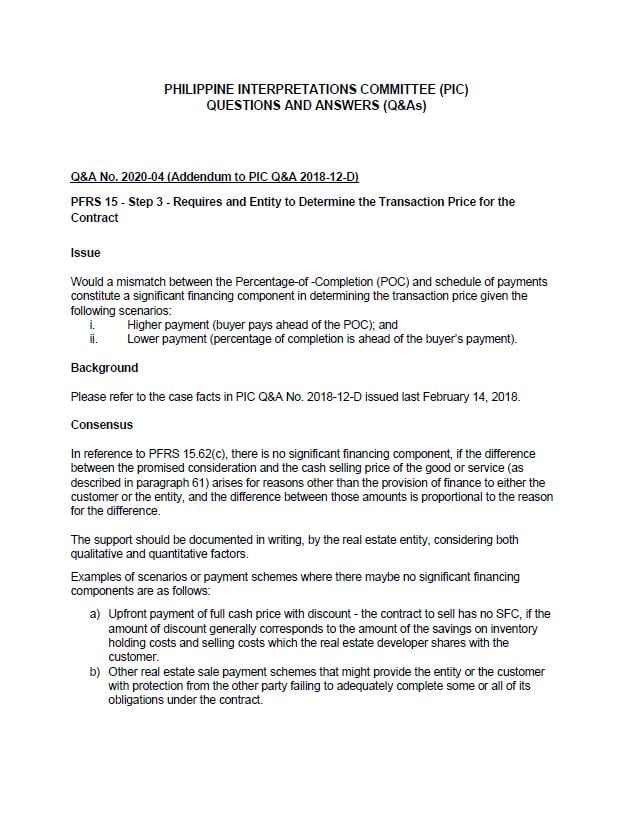Addendum to PIC Q&A 2018-12-D: Significant Financing Component Arising from Mismatch between the Percentage of Completion and Schedule of Payments
This Accounting Alert is issued to circulate Philippine Interpretations Committee (PIC) Questions and Answers (Q&A) 2020-04 dated November 6, 2020 on whether there is significant financing component arising from a mismatch between percentage of completion (POC) and schedule of payments, in accordance with PFRS 15, Revenue from Contracts with Customers.
What is the Issue?
Paragraph 60 of PFRS 15 states that in determining the transaction price, an entity shall adjust the promised amount of consideration for the effects of the time value of money if the timing of payments agreed to by the parties to the contract (either explicitly or implicitly) provides the customer or the entity with a significant benefit of financing the transfer of goods or services to the customer. In those circumstances, the contract contains a significant financing component.
Would a mismatch between the POC and schedule of payments constitute a significant financing component in determining the transaction price given the following scenarios:
- Higher payment (buyer pays ahead of the POC); and,
- Lower payment (POC is ahead of the buyer's payment).
Background
A real estate developer recognizes revenue over time using the POC method. Under this method, the developer satisfies its performance obligation to deliver a “portion” of the property to the customer over time, thus the recognition of revenue. The POC is expressed in percentage (%) based on the progress of the construction which is computed on a consistent basis in accordance with the accounting policy of the developer.
Now, given that the developer offers different payment schemes to its customers, the pattern of collection of these periodic payments may significantly be different from the POC percentage computed at any given time (i.e., end of the reporting period). These circumstances where the customer’s payment of the transaction price does not coincide with the POC percentage of the project gives rise to possibility of significant financing either by the customer to the developer or vice versa.
Consensus
In reference to paragraph 62(c) of PFRS 15, there is no significant financing component, if the difference between the promised consideration and the cash selling price of the good or service (as described in paragraph 61) arises for reasons other than the provision of finance to either the customer or the entity, and the difference between those amounts is proportional to the reason for the difference.
The support should be documented in writing, by the real estate entity, considering both qualitative and quantitative factors.
Examples of scenarios or payment schemes where there may be no significant financing components are as follows:
- Upfront payment of full cash price with discount - the contract to sell has no significant financing component, if the amount of discount corresponds to the amount of the savings on inventory holding costs and selling costs which the real estate developer shares with the customer.
- Other real estate sale payment schemes that might provide the entity or the customer with protection from the other party failing to adequately complete some or all its obligations under the contract.
Further, as provided under paragraph 63 of PFRS 15, an entity need not adjust the promised amount of consideration for the effects of a significant financing component if the entity expects, at contract inception that the timing difference of the receipt of full payment of the contract price and that of the completion of the project, are expected within one year and significant financing component is not expected to be significant.
Status and Effectivity
This Q&A is still subject for approval by the Board of Accountancy as of January 7, 2021. The effective date of the consensus in this Q&A follow that of PIC Q&A 2018-12, upon approval by the Financial Reporting Standards Council which is November 6, 2020.
See attached PIC Q&A 2020-04 for further details.

